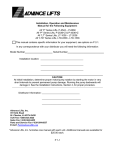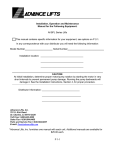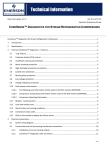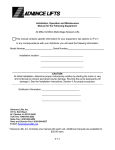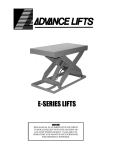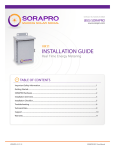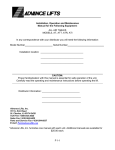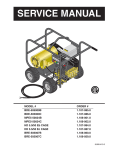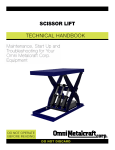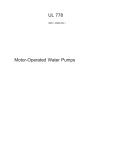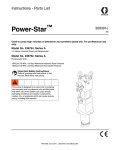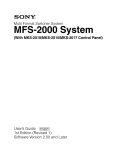Download P MANUAL WITH LT<D`s 04_09_13
Transcript
Installation, Operation and Maintenance Manual for the Following Equipment: All “P” Series Lifts, P-2524 – P-6060 All “P” Series Lifts, P-2536+Z & P-4036+Z All “LT” Series Lifts, LT-1036 – LT-2036 All “LTD” Series Lifts, LTD-0536 - LTD-1536 This manual contains specific information for your equipment, see options on P 2-1. In any correspondence with your distributor you will need the following information: Model Number______________________ Serial Number_____________________________ Installation location: __________________________________ __________________________________ __________________________________ CAUTION: At Initial Installation, determine proper motor/pump rotation by starting the motor in very short intervals to prevent permanent pump damage. Running the pump backwards will damage it. See the Installation Instructions, Section 4, for proper procedure. Distributor Information: ______________________________ _______________________________ _______________________________ Advance Lifts, Inc. 701 Kirk Road St. Charles, IL 60174-3428 Toll Free 1-800-843-3625 Sales Fax 1-630-584-9405 Parts and Service Fax 1-630-584-6837 E-mail: [email protected] *Advance Lifts, Inc. furnishes one manual with each unit. Additional manuals are available for $25.00 each. P 1-1 SECTION 2. INDEX & INTRODUCTION Identification Sheet…………………………………………………………. Index & Introduction………………………………………………………… *Responsibilities Of Owners & Users….………………..……………….. *Installation Instructions……………………………..…………………….. *Operation Instructions……………………………………………………… *Maintenance Instructions……………………………………………….. … *Maintenance Device(s) Placement Warning Label Specifications & Locations ………………………………. Hydraulic Details…………………………………………………………….. General hydraulic information Oil recommendation & seal compatibility P Series power unit photographs (Standard and Deluxe) LT Series power unit photograph LTD Series power unit photograph Hydraulic schematics Hydraulic component lists P & P-Z Series cylinder photographs P & P-Z Series cylinder drawings and parts lists LT & LTD Series cylinder photograph LT & LTD Series cylinder drawing and parts lists Cylinder repair procedures Electrical Details…………………………………………………………….. General electrical information Typical controller photograph Electrical schematics DC Electrical schematics Wire size recommendations Mechanical Details………………………………………………………….. Typical baseframe part descriptions P & LT Series leg-set part descriptions LTD leg set part descriptions Troubleshooting Hints………………………………………………………. Warranty……………………………………………………………………… Attachments: Material Safety Data Sheets & Parts List………………… Optional Accessory Information (Only included when appropriate)….. Wheel & dolly: Instructions, Photo and drawing Transport casters: Instructions, Photo and drawing Manual turntable: Instructions, Photo and drawing Powered turntable: Instructions, Photo, drawing and schematics Bellows: Photo and drawing Tilter: Instructions, Photo, Drawing and schematics External power unit: Photo and schematics Continuous running power unit: Photo and schematics Other_______________________________________ *Mandatory reading before attempting installation. P 2-1 Section 1 Section 2 Section 3 Section 4 Section 5 Section 6 Section 7 Section 8 Section 9 Section 10 Section 11 Section 12 Section 13 Section 14 SECTION 2. INTRODUCTION (CONTINUED) Congratulations, the equipment that you have purchased is of the highest quality available. Your Advance Lift will provide you with many years of trouble free service in return for the minimal maintenance described in this manual. Please be sure that no individual is allowed to operate the lift until they have been fully familiarized with the operating instructions in this manual. Also, insure that at least one person at the lift site is familiar with the maintenance section of this manual and is assigned responsibility for doing the maintenance on a regular basis. Please note that the lift has a metal nameplate attached to it that contains information such as the model number, capacities, and serial number. Do not remove the nameplate. Be sure that no operator ever exceeds the capacities shown on the nameplate or they may injure personnel or cause damage to the lift. Also, be sure to have the serial number of the lift handy if you have to call your distributor. That number identifies your specific lift and will allow your distributors personnel to give you the most thorough and timely assistance possible. This manual is under constant review and we would appreciate any constructive suggestions that may enhance its usefulness. Please send your suggestions to Advance lifts, Inc. Attn: Customer Service Department. Thank you for purchasing our product. P 2-2 SECTION 3. RESPONSIBILITIES OF OWNERS & USERS Basic Principles: Owners/users shall apply sound principles of safety, training, inspection, maintenance, and expected operating environment. It shall be the responsibility of the owner/user to advise the manufacturer where deflection may be critical to the application. Manuals: Owners/users shall keep and maintain a copy of the operating and maintenance manual(s) and ensure its availability to operating and maintenance personnel. Inspection and Maintenance: It shall be the responsibility of the users to inspect and maintain the industrial scissors lift as required to ensure proper operation. The frequency of inspection and maintenance shall be based upon the manufacturer’s recommendations and be compatible with operating conditions and the severity of the operating environment. Industrial scissors lifts that are not in proper operating condition shall be immediately removed from service until repaired. Maintenance and repairs shall be made by a qualified person and the repairs shall be in conformance with the manufacturer’s recommendations. Maintenance Safety Precautions: Before adjustments and repairs are started on an industrial scissors lift, the following precautions shall be taken as applicable: 1. Remove the load from the platform. 2. Lower platform to the full down position, if possible or secure by maintenance device and/or blocking as described by the manufacturer to prevent unintended platform movement. 3. Relieve system pressure from all circuits before loosening or removing any components. 4. All controls in the “off’ position and all operating features secured from inadvertent motion by brakes, blocks, or other means. 5. Disconnect power and follow established owner/user lockout/tag out policies. 6. Follow precautions and directions as specified by the manufacturer. Replacement Parts: When parts or components are replaced, they shall be replaced with parts or components approved by the original manufacturer of the industrial scissors lift. Maintenance Training: The owner/user shall ensure only qualified personnel inspect and maintain the industrial scissors lift in accordance with the sections: Inspection and Maintenance, Replacement Parts and Operator Training and the manufacturer’s recommendations as described in the maintenance manual. Operator Training: An owner/user, who directs or authorizes an individual to operate an industrial scissors lift, shall ensure that the individual has been: 1. Trained in accordance with the manufacturer’s operating manual. 2. Made aware of the responsibilities of operators as outlined under the Operators Section of this manual. 3. Retrained, if necessary, based on the owners/user’s observation and evaluation of the operator. Modifications: Modifications and additions shall not be performed without the manufacturer’s prior written approval. Where such authorization is granted, capacity, operation, and maintenance instruction plates, tags, or decals shall be changed accordingly. P 3-1 SECTION 3 (Continued). RESPONSIBILITIES OF OWNERS & USERS Responsibility of Operators Basic Principles: Operators shall apply sound principles of safety and good judgment in the application and operation of the scissors lift, with consideration given to its intended use and expected operating environment. Since the operator is in direct control of the industrial scissors lift, conformance with good safety practices is the responsibility of the operator. The operator shall make decisions on the consideration for the fact that his or her own safety as well as the safety of other personnel on or near the scissors lift is dependent on those decisions. General Training: Only personnel who have received general instructions regarding the inspection, application and operation of industrial scissors lifts, including recognition and avoidance of hazards associated with their operation, shall operate an industrial scissors lift. Such topics covered shall include, but not necessarily be limited to, the following issues and requirements: 1. A pre-start inspection 2. Responsibilities associated with problems or malfunctions affecting the operation of the industrial scissors lift 3. Factors affecting stability 4. The purpose of placards and decals 5. Workplace inspection 6. Safety rules and regulations 7. Authorization to operate 8. Operator warnings and instructions 9. Actual operation of the industrial scissors lift. Under the direction of a qualified person, the trainee shall operate the industrial scissors lift for a sufficient period of time to demonstrate proficiency in actual operation of the industrial scissors lift. Prestart Inspection: Before use each day or at the beginning of each shift, the industrial scissors lift shall be given a visual inspection and functional test including but not limited to the following: 1. Operating and emergency controls 2. Safety devices 3. Air or hydraulic system leaks 4. Electrical cables and wiring harness 5. Loose or missing parts 6. Wheels and casters 7. Nameplates, precautionary and instructional markings and/or labeling 8. Guardrail system 9. Items specified by the manufacturer Problem or Malfunctions: Any problems or malfunctions that affect the safety of operations shall be repaired prior to the use of the industrial scissors lift. Before Operations: The operator shall: 1. Read and understand the manufacturer’s operating instruction(s) and user’s safety rules or have them explained 2. Understand all labels, warnings, and instructions displayed on the industrial scissors lift or have them explained P 3-2 SECTION 3 (Continued). RESPONSIBILITIES OF OWNERS & USERS Responsibility of Operators Workplace Inspections: Before the industrial scissors lift is used and during use, the operator shall check the area in which the industrial scissors lift is to be used for possible hazards such as, but not limited to: 1. Bumps, floor obstructions and uneven surfaces 2. Overhead obstructions and electrical hazards 3. Presence of unauthorized persons 4. Other possible unsafe conditions as noted in the operating manual. Operator Warnings and Instructions: The operator shall ensure the operation of the industrial scissors lift is in compliance with the following: 1. Slope. The industrial scissors lift shall only be operated on flat and level surfaces. 2. Guardrail system. Guardrails shall be installed and positioned, and access gates or openings shall be secured per the manufacturer’s instructions. 3. Distribution of load. The load and its distribution on the platform and any platform extension(s) shall be in accordance with the manufacturer’s rated capacity for that specific configuration. 4. Maintaining overhead clearance. The operator shall ensure that adequate clearance is maintained from overhead obstructions and energized electrical conductors and parts. 5. Point of Operation. The operator shall not place any part of their body under the platform. 6. Personnel footing. Personnel shall maintain firm footing on dock lifts and work access lifts while working thereon. Climbing by occupants on the guardrail system is prohibited. The use of planks, ladders, or any other devices on the platform for achieving additional height is prohibited. 7. Precaution for moving equipment. When other moving equipment or vehicles are present, special precautions shall be taken to comply with the safety standards established for the workplace. 8. Reporting problems or malfunctions. The operator shall immediately report to a supervisor any problem(s) or malfunction(s) that become evident during operation. The operator shall ensure all problems and malfunctions that affect the safety of operations are repaired prior to continued use. 9. Capacity limitation. Rated capacity shall not be exceeded when loads are transferred to the platform at any level. 10. Work area. The operator shall ensure the area surrounding the industrial scissors lift is clear of personnel and equipment before lowering the platform. 11. Battery charging. Batteries shall be charged in strict accordance with the lift manufacturer’s instructions. 12. Securing the industrial scissors lift. The operator shall comply with the means and procedures provided to protect against use by an unauthorized person(s). 13. Altering safety devices. Safety devices shall not be altered or disabled. 14. Modifications. Modifications or alterations of an industrial scissors lift or the fabrication and attaching of frameworks or the mounting of attachments for holding tools or materials onto the platform or the guardrail system shall only be accomplished with prior written permission of the manufacturer. 15. Assistance to the operator. If an operator encounters any suspected malfunction or any hazard or potentially unsafe condition relating to capacity, intended use or safe operation the operator shall cease operation of the industrial scissors lift and request further instruction from the owner/user. 16. Problems or malfunctions. Any problem(s) or malfunction(s) that affect the safety of operations shall be repaired prior to the use of the industrial scissors lift. P 3-3 SECTION 4. INSTALLATION INSTRUCTIONS Floor mounted units (P, P-Z, LT and LTD Series): 1. Move the lift to the usage area; insuring the floor is clean and level. If slings are used, encircle the entire lift, not just the platform. Caution! Before securing the unit to the floor, shim or grout the entire baseframe assembly. Continuous baseframe support is essential for proper installation. 2. Using the pushbutton control or footswitch, push the “up” button in short jogs to see if the lift will rise. If the unit does not rise, check the motor rotation. On 3 phase systems, 2 of the 3 power leads may have to be switched so the pump will turn in the proper direction. Caution! Operating a hydraulic pump in reverse, even for brief periods, can cause permanent pump damage. 3. Raise the lift halfway several times then fully lower it, holding the down control an extra 10 seconds each time the lift is lowered to bleed air from the unit. 4. Lag the unit in place using ½” x 5”, “Rawl-Studs” or wedge anchors in the holes provided. 5. Clean any debris or spilled fluid as they may later be misinterpreted as mechanical trouble or a cylinder leak. While highly unlikely, it may be necessary to tighten some hydraulic fittings due to the rigors of shipping. Remove maintenance device(s) and lower the unit. 6. Instruct user(s) in the proper operation of the lift, safety precautions, and equipment capacity. Supply maintenance personnel with this service manual. Pit mounted units: 1. Check all pit dimensions for accuracy. 2. Attach a temporary electrical line through the pit conduit to the lift. Check for correct motor rotation; (see paragraph 2 in “floor mounted installation”). 3. Using slings, encircle the entire lift, not just the platform and lower the lift into the pit, centering it for 1” minimum clearance on all sides to the pit wall. 4. Raise the lift with the pushbutton or footswitch and remove the slings. Run the unit up and down several times to remove air from the hydraulic system. 5. Level and center the lift by shimming and grouting the entire baseframe, not just the corners. Lag the unit in place using ½” x 5”, “Rawl-Studs” or wedge anchors in the holes provided. Caution! Continuous baseframe support is essential for proper installation 6. With the lift fully elevated, disconnect the main power and complete the permanent electrical wiring. 7. Follow the instructions outlined in paragraphs 5 and 6 under “Floor mounted installation”. To complete the installation. P 4-1 SECTION 5. OPERATING INSTRUCTIONS Hydraulic scissors lifts have an excellent safety record overall, but as with all moving equipment, they can be dangerous. Operators must use common sense and take responsibility for the safety of everyone near the lift. They must use the safety devices provided and be careful not to surprise anyone in the area with the movement of the lift. Pre-operational checks: 1. Check all electrical wiring and connections to be sure that they are completed properly and are operational. 2. Check for obstructions or debris that may interfere with the safe operations of the lift. 3. Be sure that all personnel in the area are a safe distance away from the lift and aware that you are about to operate it. 4. If there are any optional safety devices such as bellows or electric toe guards, check them for proper operation. Test operate the equipment: 1. Station yourself so that you will always see the equipment when it is in operation. Never operate the equipment blind! 2. Raise the equipment and note that the control is a constant pressure, “dead-man” type. When you release the up or down switch the unit should stop moving immediately and maintain its elevation. If it does not, contact your maintenance personnel. 3. Cycle the equipment several times to be sure that it is operating smoothly with no jerking or sudden movement. On initial start up there may be some air in the lines or the cylinders may be dry due to storage so it my take several cycles to smooth out the operation. If the operation is not smooth after several cycles, contact your maintenance personnel. Any evidence of binding or scraping in the operation shall cause you to immediately stop using the lift. 4. Check all safety devices for proper operation. 5. If you elect to test load the equipment be sure that you do not exceed the capacities shown on the nameplate. Overloading may cause structural stresses that may not show up for some time, but will diminish the life and capacity of the unit. If you have any questions about testing the unit, call our customer service department at 1-800843-3625. Daily operation: 1. All personnel shall be required to read the entire operating instruction section of this manual prior to operating the lift. 2. Operators must know the capacity of the unit and be aware of any loads that may exceed the capacity. 3. WARNING! Operators must be alert to personnel in the vicinity of the lift. Avoid any surprises to these personnel in regard to movement of or the position of the lift. Never operate unit if you cannot see it and the personnel around it. P 5-1 SECTION 5. OPERATING INSTRUCTIONS (CONTINUED) Daily operation (continued): 4. On the first use of the lift each day, the operator shall check to see that the lift is functioning properly and smoothly. All safety devices shall be in place and operating correctly. 5. If the unit has a traveling electrical cord, the operator must insure that it is kept away from the lift as it raises and lowers. 6. Loads shall be centered before raising or lowering the lift as this will help insure even wear on all moving parts General Information Notes: 1. A special additive has been added to the hydraulic fluid to facilitate the initial breakin period for the tight tolerance, high quality, hydraulic cylinders. If the original fluid is changed, contact the factory for purchasing replacement fluid. 2. The following changes in cylinder construction and flow control design were made on April 1st, 2000. (Illustration 1-1). Proper orientation of the flow control device is critical to the performance of the lift. This flow control style was removed from service in January 1, 2010. 3. All units manufactured after April 1st, 2000 contain JIC and O-Ring Boss fittings, units manufactured before this date had NPT fittings. Caution! these fittings are not interchangeable, know the difference. Additional fittings could be needed when changing cylinders, call the factory for proper fittings and applications. (1-1) P 5-2 SECTION 6. MAINTENANCE INSTRUCTIONS 1. Always remember that machinery with large moving parts can seriously injure you. 2. Read and understand this manual before attempting any service work. 3. WARNING! Always use the maintenance device(s) when working on the unit in the elevated position or reaching under the platform. (See photos 6-1 and 6-2, at the end of this section for proper positioning and engagement of the maintenance device(s)). 4. When using the maintenance device(s), adhere to the following rules: A. The unit must be unloaded. B. Be sure the maintenance device(s) are properly engaged. C. Hold the down pedal or pushbutton an extra 10 seconds when lowering onto the maintenance device(s), to be sure that all the weight of the lift is on the device. D. Disconnect and tag the electricity to the unit to prevent accidental movement of the lift by other personnel. E. Spend as little time as possible under the lift. 5. Only use replacement parts recommended by the manufacturer. 6. Do not let the equipment stay in disrepair; fix small problems before they become big problems. A unit in disrepair can become a severe hazard if left unattended. 7. Inspect the equipment on a regular schedule, preferably monthly. 8. Never work on the hydraulics or electrical systems unless the unit is fully lowered or properly sitting on the maintenance device(s). 9. Never apply a load to the equipment until the base frame is continuously supported. 10. WARNING! Never expect to hold the leg assemblies open by simply lifting one end of a platform. A. The roller end of most lifts is not “gibbed” or captured in any way, so lifting on the roller end will simply tilt the platform. B. Even if you raise the clevis end of the platform, if the base frame is not firmly lagged to the ground or held down by some other means, the legs will come up with the platform in an unpredictable manner and could cause personal injury. C. The only safe way to hold a lift’s legs open is the factory designed maintenance device(s). Routine Maintenance: (All lifts) Weekly: Once a week or after repetitive operation, the unit shall be raise to its full height. This will get rid of cylinder oil seepage buildup and lubricate the upper cylinder barrel. On all units this fluid will be returned to the reservoir. Monthly: 1. Check the hydraulic fluid level. Caution! When checking fluid levels, make sure the unit is in the full-up position, with the maintenance device(s) in place. WARNING! Be sure the maintenance device(s) are properly engaged before performing maintenance checks 2 through 6 or reaching beneath a raised lift. (See instructions 3, 4 and 10 above). P 6-1 SECTION 6. MAINTENANCE INSTRUCTIONS (CONTINUED) 2. Clean all debris from the vicinity of floor and pit mounted units in order to avoid interference with the lift mechanism or rollers. 3. Check for presence and proper seating of all snap rings and clips on all axles, cylinder and rollers. 4. Check rollers, pins and bushings for any signs of wear such as flat spots, missing fasteners, or dislodged bearing material. 5. Check the hydraulic fittings for cracks or leaks and clean up any weepage on or beneath the cylinder. 6. Check hoses and electrical lines for abrasions or other abuse and check for snug connections. 7. Operate the unit and check for any abnormal noise or vibrations. 8. Check all safety devices on the unit such as the condition of the pleated bellows or smooth operation of the electric toe guards. Seasonal or Semiannual Maintenance: Change hydraulic fluid for ambient temperature change if appropriate or if there is any evidence of accumulated condensation creating water contamination. See page P 5-2, paragraph number 1, under the heading “General Information Notes” for more information on changing fluid. MAINTENANCE DEVICE INSTRUCTIONS WARNING! Always use the maintenance device(s) for any service or maintenance. Never go or reach under the lift unless the maintenance device(s) are securely in place and the power to the unit has been disconnected to prevent others from operating the lift. Never use the maintenance device(s) with a load on the platform. CAUTION! Never use the lift unless the maintenance device(s) are properly stored or damage may occur to the equipment. 1. Remove the maintenance device(s) from their storage positions by loosening the wing bolts or rotating into place. Raise the lift to full travel, and place the device(s) in front of each roller wheel on the scissors leg. Make sure the device(s) angle captures the base frame angle (see photos numbered 6-1 and 6-2). Caution! Do not tighten the wing bolt. 2. Once both maintenance device(s) are in place, slowly lower the lift until the roller wheel is engaged with the maintenance device(s) and the maintenance device(s) rest against the end of the base frame. Visually inspect both maintenance device(s) to insure they are secure. 3. To disengage the maintenance device(s) raise the lift to move the roller wheels off the maintenance device(s) and make sure lift operates correctly. If assistance is required in removal of the maintenance device(s), lightly tap with a hammer to break it loose. Store the maintenance device(s) in their original position and tighten the wing bolt. Store the maintenance device(s) as for forward as the retaining wire will allow. Failure to do so would allow the moving leg roller wheel to impact the maintenance device(s) when the list is full up, or the leg boss when the lift is full down, (see the photograph, 6-1 and 6-2) on page P 6-3 for more information. P 6-2 Maintenance Device(s) Usage Leg Boss Maintenance Device in Stored Position Photo 6-1 Maintenance Device in Stored Position Maintenance Device(s) in usage position Photo 6-2 Maintenance Device in Use Store the maintenance device(s) as far forward as the retaining wire will allow. Failure to do so would allow the moving leg roller wheel to impact the Maintenance Device(s) when the lift is full up, or the leg boss when the lift is full down. Also see page P 6-2 for description of Maintenance Device usage. P 6-3 Maintenance Device(s) Usage (Continued) Maintenance Device in Stowed Position Photo 6-3 Danger! Maintenance device(s) must be fully rotated to position shown in photo 6-4 for proper usage. Failure to properly position maintenance device(s) could potentially allow the device to slip out of place. Maintenance Device in Contact with Support Bar Photo 6-4 SECTION 7. WARNING LABEL SPECIFICATIONS & LOCATIONS WARNING LABEL LOCATIONS & SPECIFICATIONS The warning and informational labels normally attached to P Series, LT and LTD lifts, are shown below and their proper mounting locations are shown on page 7-2. Descriptions of the labels are as follows: Label 1: This is simply a promotional label identifying the unit as Advance Lifts unit. Label 2: This is the formal nameplate and it shall never be removed from the unit. The serial number on this nameplate is critical in identifying the specific unit for correct parts and service information. This plate also informs all readers of the proper capacity limits of the unit. Label 3: This is an important “Danger” label that warns users of the three greatest hazards. Label 4: This is a “Warning” label to not ride on the unit. Label 5: This is a “Danger” label reinforcing the need to use maintenance device(s). P 7-1 WARNING LABEL LOCATIONS PLATFORM FORMAL NAMEPLATE (DO NOT REMOVE) LABEL #2 BASEFRAME LABEL #2 PLATFORM LABEL #4 LABEL #5 BASEFRAME P 7-2 SECTION 8. HYDRAULIC DETAILS 1. Weepage and Leakage: A. All hydraulic cylinders will require the replacement of packings and seals after a period of time depending on usage and environmental conditions. It is considered normal maintenance. However maintenance personnel shall recognize the difference between leakage and weepage. B. Weepage is the normal accumulation of fluid that passes the seals in the course of operations, as the hydraulic fluid properly performs its lubrication function on cylinder walls and piston rods. It may be occasionally observed squirting from cylinder breathers, but should stop squirting after several cycles of full stroke when the small accumulation is cleared. C. Leakage is the fluid, which leaks past worn or cut packings and seals. It too may be observed squirting, but does not stop after several cycles and the lift will probably not hold position under load. D. Some units have breather lines that return any weepage or leakage of fluid from the cylinder to the reservoir. It is important to make sure the lines are not full of fluid at all times. Some visible fluid is normal; a unit that will not maintain raised height could have worn or cut packings that need to be repaired. See “Repacking” under cylinder repair procedures in Section 8, page 8-15. E. Always be careful when working around cylinders, not to nick the extended rod or dent the cylinder casing, as this may cause damage to cylinder seals or packings. F. If you elect to repaint any part of the lift, cover exposed rods with plastic or soluble grease, which can be removed after painting to insure that no paint sticks to the rods and damages the packings or seals. 2. General precautions: A. Caution! Be sure that all pressure is relieved from the hydraulic system before disassembling any components. Continue to hold the “down” control for several seconds after fully lowering the unit on its maintenance device(s) or the ground, before opening a hose line or hydraulic component. B. Always be careful to avoid contamination entering the system. Be especially careful with the ends of hoses, which may fall into oil dry, or dirt. If you suspect contamination, flush the system and components. 3. Hydraulic fittings, sealant and torque’s: A. Advance Lifts may be equipped with either NPT fittings (tapered), or SAE fittings (with O-ring seals), or JIC fittings (37-1/2˚ tapered). Know the difference. B. Be careful when tightening NPT fittings not to over-tighten and crack them. Swivel fittings are especially vulnerable and shall only be tightened enough to stop leaking. C. If leakage persists after tightening the fittings fairly hard, inspect fittings for burrs on the mating edges or the possibility of a 37-1/2˚ SAE fitting being mixed with 30˚ NPT fittings or either one being mixed with SAE 45˚ fittings. P 8-1 SECTION 8. HYDRAULIC DETAILS (CONTINUED) D. When using Teflon tape on NPT fittings, be sure the tape is started 1-1/2 threads back from the leading edge and only use 2 wraps to be sure that tape does not break off and contaminate the system. You may substitute pipe sealant with Teflon paste from “Pro Lock” or “Locktite”, but again don’t over apply. Never use sealant or tapes on JIC, O-Ring Boss or swivel fittings. E. Be extremely careful not to over-tighten ORB fittings, thread the fitting finger tight and then tighten the nut on the fitting. F. Never reuse old Teflon tape. Once a connection has been opened, remove all tape and apply fresh tape. OIL RECOMMENDATIONS AND SEAL COMPATIBILITY Fluids: 1. As of 1/1/03 the current standard hydraulic fluid is a multi viscosity ISO-46 group II base oil hydraulic fluid. This is the fluid normally supplied by the factory and is suitable for a temperature range of –10 to +100 degrees Fahrenheit. When replacing or adding fluid to an Advance Lift, use only ISO 46 hydraulic fluid that is manufactured with a group II base oil. ISO 46 hydraulic fluid can be identified by its purple color. 2. From 3/25/85 until 12/31/02 Dexron ll and Dexron lll automatic transmission fluids were supplied; the pink coloring can identify it. 3. Unless approved by the Advance lifts engineering department do not use any other fluid. Brake fluids and other hydraulic fluids may damage the system’s seals or hoses. If it is required to switch from one fluid to another, drain the reservoir and system completely, and then refill with the new fluid. 4. Biodegradable and fire retardant fluids are available. Contact the factory for specifications. It may be necessary to change some seals and/or hoses for total system compatibility, depending upon the specific model lift and the requested fluid. Options: For extremely warm temperature ranges of 120º to 140º degrees Fahrenheit, you may switch to 10W30 motor oil. If ambient temperatures are expected above 140º degrees, consult the factory. For extremely cold temperature ranges, Advance Lifts recommends the use of a fluid heater, contact your distributor for more information and specifications. Seals: Generally, the seals in the unit are Buna-N-Nitrile and polyurethane. The hoses are either PVC for suction lines or braided wire for pressure lines. Always call the factory about special fluids rather than make assumptions on your own. P 8-2 P SERIES POWER UNITS STANDARD POWER UNIT Motor Control Box Breather Plug Flow Valve Reservoir Relief Valve Down Solenoid Valve Pump Fill Level Plug Return Fluid Line Suction Line Power & Control Line See Page P 8-7 for Hydraulic Diagram and Pages 9-3 & 9-4 for Electrical Diagrams P 8-3 P SERIES POWER UNITS DELUXE POWER UNIT Pressure Line to Cylinders Control Box Reservoir Breather Plug Motor Reservoir Fluid Return Line Pump Deluxe Flow Valve Fill Level Plug Down Solenoid Relief Valve Discharge Line from Pump Suction Line See Page P 8-8 for Hydraulic Diagram and Pages 9-3 & 9-4 for Electrical Diagrams P 8-4 LT SERIES POWER UNITS Reservoir Breather Plug Control Box Motor Fluid Reservoir Pump Down Solenoid Fluid Return Line (from cylinder) Suction Line Power and Control Wires Pressure Line to Cylinder See Page P 8-8 for Hydraulic Diagram and Pages 9-3 & 9-4 for Electrical Diagrams P 8-5 LTD SERIES POWER UNITS Control Box Flow Control Valve Suction Line Down Solenoid Pump Fluid Return Line (from cylinder) Motor Reservoir Breather Plug Reservoir See Page P 8-8 for Hydraulic Diagram and Pages 9-3, 9-4, 9-5 & 9-6 for Electrical Diagrams P 8-6 P 8-7 SUCTION FILTER IN RESERVOIR MOTOR MANIFOLD ASSEMBLY RESERVOIR PUMP CHECK VALVE FLOW CONTROL MANUAL DOWN VALVE (OPTIONAL) DOWN SOLENOID PRESSURE RELIEF VALVE (PRESET BY FACTORY, DO NOT ADJUST) DISCHARGE FILTER FLOW CONTROLS, LOCATED IN CYLINDER HOUSING NIPPLE. REFER TO PAGE 8-13 FOR PROPER ORIENTATION CYLINDERS HYDRAULIC DIAGRAM FOR UNITS WITH ONE-PIECE MANIFOLDS P 8-8 RESERVOIR SUCTION LINE FILTER IN RESERVOIR PUMP MOTOR PRESSURE RELIEF VALVE (PRESET BY ADVANCE, DO NOT ADJUST) VALVING LOCATED IN PUMP DOWN SOLENOID VALVE FLOW CONTROL CHECK VALVE STANDARD P-SERIES, LT & LTD HYDRAULIC SCHEMATIC FLOW CONTROL CYLINDER QTY. VARIES BY UNIT P & LT SERIES CYLINDER (PISTON STYLE) Typical of all Advance Lifts units with “P” or “LT” in model number Retaining Ring(s) Return Port to Reservoir 5 Bearing Block Cylinder Housing 4 11 Cylinder Rod 21 Hydraulic Hose Connection Piston 31 Quad and Backup Rings 61 81 Wear Ring 9 (Reference numbers correspond with drawings on Pages 8-11, 8-12) Backup Rings Quad Seal 6 8 Rod Wiper 10 Wear Ring Static Seal 9 1 7 P & LT Series Cylinder Packing Kit Contents NOTE: LT Models Delete Rod Wiper (10) and Add a Quad Seal (11) and Spacer (12). See Drawing on P 8-12 P 8-9 P 8-10 PISTON RETAINING NUT (600 FT LBS.) O-RING WEAR RING PISTON BACK UP RINGS ROD HOUSING QUAD SEAL ROD BEARING QUAD SEAL EXTERNAL RETAINER TYPICAL P & LTD SERIES CYLINDER BEARING BLOCK ROD WIPER INTERNAL RETAINER SPACER LTD SERIES CYLINDER Bearing Retaining Ring 6 Set Screw Hole Bearing Assembly 4 Breather Line Connection Outer Bearing Seals 9 Cylinder Housing Cylinder Rod 2 1 Piston Assembly 3 Piston Seals 8 9 Hydraulic Hose Connection Snap Ring (Not visible) 5 (Reference numbers correspond with drawing on Page 8-14) Backup Ring Quad Ring 11 9 Static Seal 7 Quad Ring 10 Retaining Ring 6 Backup Rings 8 Snap Ring 5 Quad Ring Backup Ring 13 12 P 8-11 P 8-12 NOTE: SOME UNITS WERE MANUFACTURED WITH TWO BACKUP RINGS RETAINING CLIP PISTON QUAD SEAL ROD HOUSING O-RING SEAL BACKUP RING BEARING QUAD SEAL TYPICAL LTD-SERIES CYLINDER QUAD SEAL BACKUP RING RETAINING CLIP REPAIR PROCEDURES FOR P, LT AND LTD CYLINDERS Tools & Supplied required: “Lubriplate” and hydraulic fluid matching the existing fluid in the system for topping off the reservoir when finished. (Current standard fluid is ISO 46 Hydraulic fluid) A five- (5) gallon bucket to collect fluid from the cylinders. Wrenches to disconnect hydraulic fittings. Emery cloth. Clean lint free cloths and hose caps. Clean work surface (butcher paper on top of most surfaces works well), with a means of holding the cylinder in a fixed position for disassembly and re-assembly. Maintenance Device(s) supplied with each Advance unit. P& LT Series lifts: (1) Snap ring tool (Waldes Truarc external type #S-660 or Industrial pliers #P-104.) Cylinders hone (Craftsman glaze breaker #9K4633 or equivalent.) LTD Series lifts: (1) Small screwdriver, (1) 1/8” Allen wrench and a cylinder hone. Cylinder Removal, P and LT Series units: 1. Raise the empty lift and settle it securely on its maintenance device(s). 2. Once settled securely, depress the down control an additional 20 seconds to relieve any pressure from the hydraulic system. Remove the power connection to the power unit and mark with a warning label or lock the connection out to prevent unintended reconnection. (Check your company lockout and tag Standard Operating Procedures.) 3. Disconnect the hydraulic hose from the cylinder and cap the hose to prevent contamination. 4. Remove the cylinder from the lift by freeing the upper pin and swinging the cylinder into an easily supported position, then lift from the assembly. 5. Place the hose connection end of the cylinder in a 5-gallon bucket and force the cylinder closed to drain the hydraulic fluid from the cylinder. Do not reuse the fluid unless you are sure it is contamination free by careful straining. Cylinder Removal, LTD Series units: 1. Follow steps 1-4, under “cylinder removal, P and LT Series units. 2. Remove the retaining ring from the outside of the lower cylinder pin. 3. Gently push the pin through the cylinder assembly and remove, being careful not to damage the pin surface. 4. Follow step 5, under “cylinder removal, P and LTD Series units. P & LT Series (piston style) Cylinder Disassembly: 1. Secure the cylinder with a rod through the clevis or cross tube. Do not use a vise, which will crush or otherwise damage the housing. 2. 3” I.D. Cylinders: Use a small screwdriver to remove the outside retaining ring in front of the cylinder bearing. Remove the spacer ring, slide the front bearing into the cylinder then remove the second retaining ring. P 8-13 P & LT Series (piston style) Cylinder Disassembly: (Continued) 3. 3-1/2” I.D. Cylinders: Use the snap ring pliers to compress the retaining ring, and continue to hold it compressed. 4. Pull out the rod, bearing and piston assembly. The retaining ring groove in the housing can cut the piston seal upon removal, clean the groove thoroughly before assembly. 5. Remove the hex nut or snap ring adjacent to the piston, then slide the piston and bearing off the rod. The hex nut can be very tight, if difficulty is encountered in removal a small amount of heat can be applied to help break the nut loose. Clean all the parts and place them on a clean surface to avoid contamination. P & LT Series Re-packing and Inspection: 1. Carefully inspect the entire housing with a flashlight, for any evidence of rust, scratches or surface blemishes. Small blemished may be removed with fine emery cloth and lager faults will require the use of the hone listed on the previous page. Be sure thoroughly clean the housing when you are done to avoid contamination. 2. Do not become the victim of a false economy by using only part of a re-packing kit. Since you have invested in disassembling the cylinder, use all new packing parts and seals or the reused old parts may fail in the near future causing a repeat of the whole exercise. 3. Remove the rod wiper on the bearing by using a screwdriver to bend the seal inward to collapse and remove it. Inspect the groove. 4. Lubricate and insert a new wiper with your fingers, sliding it into its groove. Depending upon temperature, the rod wiper may slide in mush easier if it is warmed in hot water, then dried, lubricated, and inserted. The bearing may now be slid back onto the rod. 5. Begin re-packing the piston by using a screwdriver to carefully remove the old backup rings and seal from the groove. The cylinder is also equipped with a wear ring that shall be removed at this time. Be careful to leave the grooves nick free and clean. 6. Place the static O-ring seal into the clean and dry groove on the cylinder rod. Lubricate the seal surfaces and the I.D. of the piston bore. Slide the piston back into position noting that the flat side, not the chamfered side, shall rest against the retaining ring or nut. Reinstall the retaining ring or nut using Locktite if the fastener is a plain nut; torque the nut to 600ft. /lbs. 7. Clean the grooves on the piston. Place the packing kits and wear ring in place into the clean and dry grooves. Lubricate the OD of the piston seals, wear ring and the housing snap ring grooves, then slide the entire assembly into the housing. 8. Re-assemble the bearing block in the reverse manner that it was disassembled. In all cases, be sure the retaining rings(s) are fully seated into their grooves or the cylinders will come apart when fully extended, causing an accident. LTD Series Cylinder Disassembly: 1. Secure the cylinder with a rod through the clevis or cross tube. Do not use a vise, which will crush or otherwise damage the housing. 2. Gently pull the cylinder rod out of the housing, when the rod cannot be pulled out any further, push the rod back in approximately 2 inches. P 8-14 LTD Series Cylinder Disassembly (Continued): 3. Using a quick motion, pull the rod assembly out of the housing by striking the piston against the bearing block assembly. (See page P 8 -13 for descriptions of parts). This process may need to be repeated several times to free a stubborn bearing assembly. 4. Once the rod has been removed from the housing, remove the retaining clip from the end of the rod. The piston may now be removed. 5. Remove all seals and inspect seal groves for debris, take care to clean each groove carefully. Once parts are dissembled and clean, place all parts on a clean surface to avoid contamination. LTD Series Re-packing and Inspection: 1. Carefully inspect the entire housing with a flashlight, for any evidence of rust, scratches or surface blemishes. Small blemished may be removed with fine emery cloth and lager faults will require the use of a cylinder hone. Be sure to thoroughly clean the housing when you are done to avoid contamination. 2. Do not become the victim of a false economy by using only part of a re-packing kit. Since you have invested the time in disassembling the cylinder, use all the new packing parts and seals. Any used parts may fail in the near future causing a repeat of the whole exercise. 3. Lubricate all seal components before attempting to install them. 4. Install the quad ring and backup rings on the inside and outside of the bearing block. Be certain they are orientated as illustrated on page P 8-13, items # 8 and 9. 5. Lubricate the cylinder rod assembly and insert it into the bearing block assembly as shown on page P 8-13. 6. Install the static O-ring seal in the groove provided on the rod end and install the piston assembly and retaining ring 7. Clean the grooves on the piston. Place the packing kits and wear ring in place into the clean and dry grooves. Lubricate the OD of the piston seals and the housing snap ring grooves then slide the entire assembly into the housing. 8. Re-assemble the bearing block in the reverse manner that it was disassembled. Warning! In all cases, be sure the retaining ring is fully seated into the grooves or the cylinder will come apart when fully extended, causing an accident. P 8-15 SECTION 9. ELECTRICAL DETAILS General Electrical Information (P-Series Units): The motor supplied as standard on P-Series units is a 208/230/460v 3-phase motor, with connection diagrams on the outside of the motor for low voltage (230V) or high voltage (460V). This motor is also rated for 208V. As any standard motor is rated for ±10% of voltage variation, this motor will operate properly, within ratings, at 208, 220, 230, 240, 440,460, and 480V, 3-phase supply. If motor is intended for 208V line usage, some caution is advised, if your motor is a 230 volt motor, and your 208V line voltage drops to 207 volts, (a drop of only ½%), the motor will be operating at –10% in a marginal region. Wiring runs and actual voltage become very important. If you line voltage will be varying (due to loads elsewhere in the system, etc.) you may have an advantage by ordering as an option a 208V +/-10% motor. To reverse the direction of rotation of a 3-phase motor, reverse any two of the three power leads to the motor. On single-phase motors, see wiring diagram on motor. General Electrical Information (LT & LTD SERIES UNITS): The one-half horsepower motor supplied as standard on LT & LTD units is a 115/230V single-phase motor. The 115V single-phase units are designed to be operated from a 15 AMP wall outlet. General Electrical Information (LT-2036 UNITS ONLY) The one horsepower motor supplied as standard on LT-2036 units is a 115/230V single-phase motor. It is designed to be operated from a 20 AMP wall outlet. Field Changes in Voltage, 3-Phase (230V to 460V): A. Change transformer primary connections to 460V. B. Change overload protection to proper value as per currents in motor tables. Order new overload; adjust new overload to motor full load current setting. Insure the overload is set to “manual” reset, not “automatic” to insure the equipment cannot restart automatically. C. Change motor connections for high (460V). D. Change plug and receptacle for power, if required. Field Changes in Voltage, 3-Phase (460V to 230V): A. Change transformer primary connections to 230V. B. Change overload protection to proper value as per currents in motor table. Order new overload; adjust new overload to motor full load current setting. Insure the overload is set to “manual” reset, not “automatic” to insure the equipment cannot restart automatically. C. Change motor connections for low (230V). D. Change plug and receptacle for power, if required. IMPORTANT: When making voltage changes, insure motor rotation is correct. P 9-1 DC POWERED UNITS General Information: 1. All DC powered units are shipped fully charged and ready to operate. 2. The battery charger control settings are preset from the factory and shall never need to be changed. 3. The standard settings are (left to right), Switch #1: 12 Volt, 10 Amp, Switch #2: Automatic, Switch #3: 2 Amp, 12 Volt. DANGER! Never switch to the “50 Amp-Start” button setting or battery damage could occur. DANGER! Overcharging could damage the battery or cause an explosion! 4. If the unit is being used unplugged, it must be plugged in overnight to be recharged. 5. The charging system is completely automatic, and will stop charging when the battery is fully charged. 6. WARNING! Never use the charger for any other application. GENERAL BATTERY SAFETY 1. Before operating the unit, read all instructions and cautions. 2. Do not operate the unit if the power cord is damaged in any way. 3. Always unplug the unit using the plug, never unplug the unit with the cord or damage to the cord could occur. 4. Place the cord where it is safe from being walked on or where other equipment could damage it. 5. Always unplug the unit before any maintenance is performed. 6. NEVER charge the unit in a confined area. Always use the unit in a well-ventilated area DANGER! Risk of explosive gas. 7. NEVER charge the unit if the battery is frozen, allow time to thaw battery before charging. DANGER! Never smoke or operate charger around sources of ignition. Batteries produce explosive gases when charging. P 9-2 P 9-3 X1 H1 H3 24V H2 KLDR 1 FUSES L3 L2 L1 Typical break point for lower limit switch Typical break point for upper limit switch PLUG GROUND (GREEN) NEUTRAL (WHITE) HOT (BLACK) X2 H4 T3 T2 T1 115V 1Ø OPERATION M2 M1 MOTOR FNM 3 2/10 FUSE PUSH BUTTON STATION DOWN UP XF PLUG GROUND (GREEN) NEUTRAL (WHITE) HOT (BLACK) X1 H1 24V H2 X2 A1 H4 MOTOR STARTER A2 MOTOR OVERLOAD 95 M2 M1 MOTOR OVERLOAD 96 T3 T2 T1 MOTOR SINGLE PHASE ELECTRICAL DIAGRAM DOWN SOLENOID H3 KLDR 1 FUSES L3 L2 L1 230V 1Ø OPERATION P 9-4 X1 H1 H3 24V H2 KLDR 1 FUSES X2 H4 L3 L2 L1 Typical break point for lower limit switch Typical break point for upper limit switch PLUG Z Y X MOTOR OVERLOAD T3 T2 T1 M3 M2 M1 460V 3Ø OPERATION MOTOR FNM 3 2/10 FUSE PUSH BUTTON STATION DOWN UP XF PLUG Z Y X X1 H1 24V H2 X2 A1 H4 MOTOR STARTER A2 MOTOR OVERLOAD 95 M3 M2 M1 MOTOR OVERLOAD 96 T3 T2 T1 MOTOR THREE PHASE ELECTRICAL DIAGRAM DOWN SOLENOID H3 KLDR 1 FUSES L3 L2 L1 230V 3Ø OPERATION P 9-5 GREEN WHITE BLACK PUSHBUTTON STATION FOOTSWITCH OPTION GND L2 L1 MOLDED PLUG AND CABLE DOWN LIMIT SWITCH (OPTIONAL) UP LIMIT SWITCH (OPTIONAL) DOWN SOLENOID 4 1 R W BLK T8 T2, T4 T1, T3, T5 LTD ELECTRICAL DIAGRAM 3 2 POTENTIAL RELAY CONTACTOR USED WITH UPPER LIMIT SWITCH (OPTIONAL) P 9-6 BATTERY CHARGER DOWN UP - + 12VDC BATTERY MAIN POWER WIRE LT & LTD DC ELECTRIC SCHEMATIC MOTOR RUN SOLENOID MOTOR/PUMP/ RESERVOIR DOWN SOLENOID SECTION 10. BASIC PART IDENTIFICATION PLATFORM WEAR PAD ROLLER WHEEL RETAINING RING WHEEL PIN PLATFORM PIN WHEEL SPACERS MOTOR MAIN AXLE CYLINDER PIN CYLINDER ROD PUMP CYLINDER CONTROL BOX OUTER LEG ASSEMBLY OIL RESERVOIR INNER LEG ASSEMBLY P 10-1 BASEFRAME SECTION 11. TROUBLESHOOTING HINTS Warning! Only qualified service personnel shall undertake service work on hydraulic lifts. The service person shall be able to read and understand wiring and hydraulic diagrams, know how to safely troubleshoot live electrical circuits and be familiar with this manual and all safety devices on the lift. Contact your distributor if you need assistance in troubleshooting your equipment. Warning! No work shall be performed beneath a raised lift platform unless the maintenance device(s) is installed in accordance with Section 6 of this manual Symptom Probable Cause Corrective Action Equipment does not raise, motor is running Load is too heavy Reduce weight to rated load Motor rotation is reversed On three phase units, have an electrician reverse any two power leads on the power plug to reverse rotation. (Note: that the hydraulic pump can not be run backwards for more than a few seconds without suffering severe damage). Motor may be singlephasing Check wiring and overloads to determine that all three phase lines are present at the motor. Low voltage at motor terminals Check voltage at motor terminals while unit is under full load. If current is below requirements in Section 9 of this manual, correct the wire size or run length. Pinched hydraulic line Check to see that no lines are pinched. Correct as necessary. Low oil level in reservoir Check oil level and correct as necessary. If oil is low, check for leaks also. Clogged reservoir breather Check that air can pass freely through filter and correct as necessary. Clogged suction line Observe the clear suction line to be sure that it remains full of oil with no air bubbles at anytime. If there are any bubbles, check for a loose fitting, cracked ports or a clogged suction filter. SECTION 11. TROUBLESHOOTING HINTS (CONTINUED) Symptom Equipment does not raise (continued) Equipment raises too slowly Probable Cause Corrective Action Down solenoid wired Incorrectly to energize with up circuit Hold screwdriver on down solenoid and press “up” switch. If you feel magnetism correct the lift wiring. Down solenoid stuck open Remove the down solenoid and check for free movement of the plunger. Pump failure Place gauge on pump and if it does not produce 3200 psi., replace pump. Load is too heavy Reduce weight to rated Pinched hydraulic line Check to see that no lines are pinched. Correct as necessary. Dirt in down solenoid Clean the down so that it may fully close. Wrong oil for ambient temperature See oil recommendations in Section 8 of the manual. Dirt in reservoir breather Clean air breather. Low voltage at motor Check voltage at motor terminals while unit is under full load. If current is below requirements in section 9 of this manual, correct the wire size or run length. SECTION 11. TROUBLESHOOTING HINTS (CONTINUED) Symptom Probable Cause Corrective Action Equipment raises too slowly (continued) Clogged suction line. Observe the clear suction line to be sure it remains full of oil with no air bubbles at anytime. If there are any bubbles, check for loose fittings, cracked ports or clogged suction filter. Motor heats or labors excessively. Low voltage at motor terminals. Check voltage at motor terminals while unit is under full load. If current is below requirements in Section 9 of this manual, correct the wire size or run length., Wrong oil for ambient temperature. See oil recommendations in Section 8 of manual. Load is too heavy. Reduce load to rated load. Operation is spongy. Air in cylinders. Bleed the cylinders to remove air trapped in them. If this reoccurs, check for air bubbles in the suction line and air leaks. Equipment lowers too slowly. Pinched hydraulic line. Check to see that no lines are pinches. correct if necessary. Dirt in flow control valve. Remove and clean flow control valve. Dirt in check valve. Remove and clean check valve. Dirt in flow control valve. Remove and clean flow control valve. Equipment lowers too fast. SECTION 11. TROUBLESHOOTING HINTS (CONTINUED) Symptom Lift raises, then Lowers. Probable Cause Corrective Action Dirt in check valve. Remove and clean check valve. Down solenoid wired Incorrectly. Hold screwdriver on down solenoid and if you feel magnetism correct the lift wiring. Leaking cylinder packings. Repack cylinders. Faulty solenoid valve Replace valve. Down solenoid incorrectly wired. Rewire per diagram in Section 9 of this manual. Faulty solenoid coil. Replace coil. Obstruction in baseframe. Raise lift to clear obstruction then remove. Oil spraying out of reservoir. Clogged air breather. A dirty breather filter may build up positive pressure which will spray oil. Clean air breather. Lift will not raise and motor will not run. Control voltage fuse blown. Replace fuse. Motor starter overload Reset motor starter. Wrong voltage to unit. Check wiring to confirm wiring is compatible with available power. Transformer connections loose. Check and tighten terminal screws on transformer. Transformer defective. Replace transformer. Pushbutton defective Replace pushbutton DC units: See Battery charging instructions. Lift raises, but will not lower. SECTION 12. ADVANCE LIFTS INC. WARRANTY For a period of one year from date of shipment from the Company’s plant, the Company agrees to replace or repair, free of charge, any defective parts, material, or workmanship on new equipment. This shall include electrical and hydraulic components. For a period of ten years or 250,000 cycles (whichever occurs first) from date of shipment from Company’s plant, the Company agrees to replace or repair any defective structure. Company authorization must be obtained prior to the commencement of any work. The Company reserves the right of choice between effecting repairs in the field or paying all freight charges and effecting the repairs at the Company’s plant. The Company further reserves the right of final determination in all warranty considerations. Evidence of overloading, abuse, or field modification of units without Company approval shall void this warranty. No contingent liabilities will be accepted. Damage incurred in transport is the responsibility of the carrier and is not covered by this warranty. Any damage detected upon receipt of equipment should be immediately reported to the carrier. If you need assistance filing your claim, please contact Advance Lifts. P 12-1 SECTION 13. PARTS LISTS P-SERIES LIFTS GENERAL DESCRIPTION DETAIL DESCRIPTION MECHANICAL: (COMMON TO ALL UNITS, SELECT BY DATE OF MANUFACTURE) WHEEL (BEFORE 1/1/02) P,SL-232,AL,SAL,WHEEL ASM,3,.875 WHEEL (AFTER 1/1/02) P,SAL,BALL BRG WHEEL ASM,3,.875 WHEEL PIN (BEFORE 1/1/02) PIN,1,1.658,GRVD END,BVLD END WHEEL PIN (AFTER 1/1/02) P,BALL BRG RLLR WHL PIN WHEEL PIN SNAP RING 1" (ALL) RR,ROTO-CLIP,SHR-98-1IN PLATFORM PIN (1" X 2") (ALL) PIN,1,2.092,GRVD ENDS PLATFORM PIN SNAP RING 1" (ALL) RR,ROTO-CLIP,SHR-98-1IN LEG TO BASEFRAME PIN (1" X 1-7/8") (ALL) PIN,1,1.875,BVLD END LEG TO BASEFRAME PIN SNAP RING 1" (ALL) RR,ROTO-CLIP,SHR-98-1IN PART # P-006-223 P-023-878 P-A-0230 P-A-9708 P-001-876 P-A-0234 P-001-876 P-A-0235 P-001-876 COMPLETE CYLINDER: (SELECT BY VOLTAGE, PHASE AND MANUFACTURE DATE) Lifts manufactured before 4/1/00 will also require an SAE to NPT elbow part # P-010-219 NOTE: (Left and right cylinder ports are described as viewed from the roller end of the lift) MODEL# P-2524 RIGHT PORT (BEFORE 1/1/02) P-2524,P-6024,CYL ASM,RT,3.5B,1.75R P-2524 LEFT PORT (BEFORE 1/1/02) P-2524,P-6024,CYL ASM,LT,3.5B,1.75R P-2524 RIGHT PORT (AFTER 1/1/02) P-6024,CYL ASM,RT,3.5B,1.75R,4.5S P-2524 LEFT PORT (AFTER 1/1/02) P25/6024,CYL ASM,LT,3.5B,1.75R,4.5S P-2536 RIGHT PORT (ALL) P-2536,P-6036,CYL ASM,RT,3.5B,1.75R P-2548 RIGHT PORT (ALL) P-2548,P-6048,CYL ASM,RT,3.5B,1.75R P-2548 LEFT PORT (ALL) P-2524,P-6048,CYL ASM,LT,3.5B,1.75R P-2560 RIGHT PORT (BEFORE 1/1/02) P-2560/6060,CYL ASM,RT,3.5B,1.75R P-2560 RIGHT PORT (AFTER 1/1/02) P-2560/6060,CYL ASM,RT,3.5B,1.75R P-2560 LEFT PORT (AFTER 1/1/02) P-2560/6060,CYL ASM,LT,3.5B,1.75R P-4024 RIGHT PORT (BEFORE 1/1/02) P-4024,CYL ASM,RT,3.0B,1.75R P-4024 LEFT PORT (BEFORE 1/1/02) P-4024,CYL ASM,LT,3.0B,1.75R P-4024 RIGHT PORT (AFTER 1/1/02) P-4024,CYL ASM,RT,3.0B,1.75R P-4024 LEFT PORT (AFTER 1/1/02) P-4024,CYL ASM,LT,3.0B,1.75R P-4036 RIGHT PORT (ALL) P-4036,CYL ASM,RT,3.0B,1.75R P-4036 LEFT PORT (ALL) P-4036,CYL ASM,LT,3.0B,1.75R P-4048 RIGHT PORT (ALL) P-4048,CYL ASM,RT,3.0B,1.75R P-4048 LEFT PORT (ALL) P-4048,CYL ASM,LT,3.0B,1.75R P-4060 RIGHT PORT (BEFORE 1/1/02) P-4060,CYL ASM,RT,3.0B,1.75R P-4060 LEFT PORT (BEFORE 1/1/02) P-4060,CYL ASM,LT,3.0B,1.75R P-4060 RIGHT PORT (AFTER 1/1/02) P-4060,CYL ASM,RT,3.0B,1.75R P-4060 LEFT PORT (AFTER 1/1/02) P-4060,CYL ASM,LT,3.0B,1.75R P-6024 RIGHT PORT (BEFORE 1/1/02) P-2524,P-6024,CYL ASM,RT,3.5B,1.75R P-6024 LEFT PORT (BEFORE 1/1/02) P-6024,CYL ASM,LT,3.5B,1.75R P-6024 RIGHT PORT (AFTER 1/1/02) P-6024,CYL ASM,RT,3.5B,1.75R P-6024 LEFT PORT (AFTER 1/1/02) P2524,6024,CYL ASM,LT,3.5B,1.75R P-6036 RIGHT PORT (ALL) P-2536,P-6036,CYL ASM,RT,3.5B,1.75R P-6036 LEFT PORT (ALL) P-6036,CYL ASM,LT,3.5B,1.75R P-6048 RIGHT PORT (ALL) P-2548,P-6048,CYL ASM,RT,3.5B,1.75R P-6048 LEFT PORT (ALL) P-6048,CYL ASM,LT,3.5B,1.75R P-6060 RIGHT PORT (BEFORE 1/1/02) P-2560/6060,CYL ASM,RT,3.5B,1.75R P-6060 LEFT PORT (BEFORE 1/1/02) P-6060,CYL ASM,LT,3.5B,1.75R P-6060 RIGHT PORT (AFTER 1/1/02) P-2560/6060,CYL ASM,RT,3.5B,1.75R P-6060 LEFT PORT (AFTER 1/1/02) P-2560/6060,CYL ASM,LT,3.5B,1.75R P-003-478 P-003-479 P-022-066 P-022-068 P-003-482 P-003-486 P-003-487 P-020-231 P-022-017 P-022-011 P-003-480 P-003-481 P-021-984 P-021-987 P-004-222 P-004-223 P-003-488 P-003-489 P-020-343 P-020-344 P-022-006 P-022-010 P-003-478 P-003-479 P-022-066 P-022-068 P-003-482 P-003-483 P-003-486 P-003-487 P-020-231 P-020-230 P-022-017 P-022-011 SECTION 13. PARTS LISTS (CONTINUED) CYLINDER PARTS: (SELECT BY MODEL NUMBER) CYLINDER PACKING KIT FOR 3" BORE CYLINDER PACKING KIT FOR 3-1/2" BORE ROD ASM. FOR P 2524, P 4024 AND P 6024 ROD ASM. FOR P 2536, P 4036 AND P 6036 (ALL) ROD ASM. FOR P 2548, P 4048 AND P 6048 (ALL) ROD ASM. FOR P 2560, P 4060 AND P 6060 (BEFORE 1/1/02) ROD ASM. P 2524, P 4024, P 6024 (AFTER 1/1/02) ROD ASM. P 2560, P 4060, P 6060 (AFTER 1/1/02) BEARING ASSEMBLY 3" BORE (BEFORE 1/1/02) BEARING ASSEMBLY 3-1/2" BORE (BEFORE 1/1/02) BEARING ASSEMBLY 3" BORE (AFTER 1/1/02) BEARING ASSEMBLY 3-1/2" BORE (AFTER 1/1/02) PISTON, 3" BORE PISTON, 3-1/2" BORE CYLINDER PIN (BEFORE 1/1/02) CYLINDER PIN (AFTER 1/1/02) CYLINDER PIN, 6000 LBS. CAP. LIFTS (AFTER 1/1/02) CYLINDER PIN SNAP RING 1" FLOW CONTROL CARTRIDGE, 1.5 GPM (PRE 04/00) BLACK HEXAGONAL FLOW CONTROL(AFTER 04/00) P-40XX,CYL PKG KIT,3.0B,1.75R P-XXXX,CYL PKG KIT,3.5B,1.75R P-XX24,ROD ASM P-2536,P-6036,ROD ASM P-XX48,ROD ASM P-XX60,ROD,1.75R,25.125 P-XX24,ROD,1.75,11.875 P-6060,ROD,1.75,25.8125 CYL BRG BLK ASM,3.0B,1.75R,2.44 CYL BRG BLK ASM,3.5B,1.75R,2.44 CYL BRG BLK,3.0B,1.75R,2.191 CYL BRG BLK,3.5B,1.75R,2.19 PISTON,3.0B,1.75R,1.5 PISTON,3.5B,1.75R,1.75 PIN,1,4.875,GRVD ENDS PIN,1,4.625,GRVD ENDS PIN,1,4.813,GRVD ENDS,140KSI MU RR,ROTOCLIP,SHR-98-1IN HV,VONBERG,FIXED 1.5,1302-1-1.5 HV,HYDRAF,ORIFICE,1.5GPM,BLACK P-004-167 P-003-875 P-004-331 P-003-867 P-004-082 P-A-9452 P-A-9730 P-A-9736 P-003-923 P-003-874 P-A-9726 P-A-9677 P-A-1409 P-A-1551 P-A-1951 P-A-9717 P-A-9707 P-001-876 P-001-301 P-015-395 COMPLETE POWER UNIT WITH PUSHBUTTON: (SELECT BY MODEL, VOLTAGE AND PHASE) P-2524, 115 VOLT, 1 PH, 24VA P-2524,1/1,115,24,PU W/CTL,PB P-004-723 P-2524, 230 VOLT, 1 PH, 24VA P-2524, 230 VOLT, 3 PH, 24VA P-2524, 460 VOLT, 3 PH, 24VA P-2524,1/1,230,24,PU W/CTL,PB P-2524,1.5/3,230,24,PU W/CTL,PB P-2524,1.5/3,460,24,PU W/CTL,PB P-004-725 P-004-682 P-004-712 P-4024, P-6024, 115 VOLT, 1 PH, 24VA P-4024,6024,1/1,115,24,PU W/CTL,PB P-004-726 P-4024, P-6024, 230 VOLT, 1 PH, 24VA P-4024,6024,1/1,230,24,PU W/CTL,PB P-004-727 P-4024, P-6024, 230 VOLT, 3 PH, 24VA P-4024,6024,1.5/3,230,24,PU W/CTL,PB P-004-683 P-4024, P-6024, 460 VOLT, 3 PH, 24VA P-4024,6024,1.5/3,460,24,PU W/CTL,PB P-004-713 P-2536, 115 VOLT, 1 PH, 24VA P-2536,1/1,115,24,PU W/CTL,PB P-004-728 P-2536, 230 VOLT, 1 PH, 24VA P-2536,1/1,230,24,PU W/CTL,PB P-004-729 P-2536, 230 VOLT, 3 PH, 24VA P-2536,2/3,230,24,PU W/CTL,PB P-003-878 P-2536, 460 VOLT, 3 PH, 24VA P-2536,2/3,460,24,PU W/CTL,PB P-004-714 P-4036, P-6036, 115 VOLT, 1 PH, 24VA P-4036,6036,1/1,115,24,PU W/CTL,PB P-004-730 P-4036, P-6036, 115 VOLT, 1 PH, 24VA P-4036,6036,1/1,230,24,PU W/CTL,PB P-004-731 P-4036, P-6036, 230 VOLT, 3 PH, 24VA P-40/6036,2/3,230,24,PU W/CTL,PB P-004-430 P-4036, P-6036, 460 VOLT, 3 PH, 24VA P-40/6036,2/3,460,24,PU W/CTL,PB P-004-715 P-2548, 115 VOLT, 1 PH, 24VA P-2548,1/1,115,24,PU W/CTL,PB P-004-732 P-2548, 230 VOLT, 1 PH, 24VA P-2548,1/1,230,24,PU W/CTL,PB P-004-733 P-2548, 230 VOLT, 3 PH, 24VA P-2548,2/3,230,24,PU W/CTL,PB P-004-644 P-2548, 460 VOLT, 3 PH, 24VA P-2548,2/3,460,24,PU W/CTL,PB P-004-716 P-4048,6048,1/1,115,24,PU W/CTL,PB P-4048,6048,1/1,230,24,PU W/CTL,PB P-40/6048,2/3,230,24,PU W/CTL,PB P-40/6048,2/3,460,24,PU W/CTL,PB P-004-734 P-004-735 P-004-645 P-004-717 MR,LEESON,1,17,1,092032.00 MR,LEESON,1.5,17,3,092062.00 MR,LEESON,2,17,3,092139.00 P-000-330 P-001-450 P-001-451 P-4048, P-4048, P-4048, P-4048, P-6048, P-6048, P-6048, P-6048, 115 115 230 230 VOLT, VOLT, VOLT, VOLT, 1 1 3 3 PH, PH, PH, PH, 24VA 24VA 24VA 24VA MOTOR: (SELECT BY VOLTAGE AND PHASE) 115/208/230 VOLT, 1 PH 208/230/460/480 VOLT, 1.5 HP, 3 PH 208/230/460/480 VOLT, 2 HP, 3 PH SECTION 13. PARTS LISTS (CONTINUED) PUMP: (SELECT BY MODEL NUMBER) P-2524,4024,6024, WITH 1 PHASE MOTOR P-2524,4024,6024, WITH 3 PHASE MOTOR P-2536,4036,6036 WITH 1 PHASE MOTOR P-2536,4036,6036 WITH 3 PHASE MOTOR P-2548,4048,6048, WITH 1 PHASE MOTOR P-2548,4048,6048, WITH 3 PHASE MOTOR HP,1,.097,17,INT,1003220 HP,1,.161,17,INT,1003219 HP,1,.097,17,INT,1003220 HP,1,.226,17,INT,1003214 HP,1,.161,17,INT,1003219 HP,1,.226,17,INT,1003214 P-000-346 P-000-344 P-000-346 P-000-348 P-000-344 P-000-348 HYDRAULIC: (COMMON TO ALL UNITS) MANIFOLD VALVE ASSEMBLY VALVE MANIFOLD ASM P-004-420 CHECK VALVE HV,DELTA,CHECK VALVE,85002355 P-001-262 24V DOWN SOLENOID VALVE AND COIL ASM HV,DELTA,DOWN SOLENOID W/24V COIL P-001-259 24V DOWN SOLENOID COIL ONLY HV,DELTA,24V COIL, 36910038 P-001-260 DOWN SOLENOID VALVE 24V/115V 115V DOWN SOLENOID COIL ONLY 24V BARNES DOWN SOLENOID COIL HV,DELTA,DOWN SOLENOID,85002355 HV,DELTA,115V COIL,39670035 HV,BARNES,24VAC COIL,6316024 P-001-279 P-001-261 P-015-301 115V BARNES DOWN SOLENOID COIL HV,BARNES,115V COIL,6315115 P-001-741 BARNES 115V/24V DOWN SOLENOID VALVE HV,BARNES,SOLNOID CART,SV08-20S0N0 P-003-106 ADJUSTABLE FLOW CONTROL VALVE HV,DELTA,ADJ FLOW,85002019 P-001-265 CONTROLLER:(SELECT BY UNIT, VOLTAGE AND PHASE) P-2524,4024,6024, 115V, 1 PHASE P-2524,4024,6024, 230V, 1 PHASE P-2524,4024,6024, 230V, 3 PHASE P-2524,4024,6024, 460V, 3 PHASE P-2536,4036,6036, 115V, 1 PHASE P-2536,4036,6036, 230V, 1 PHASE P-2536,4036,6036, 230V, 3 PHASE P-2536,4036,6036, 460V, 3 PHASE P-2548,4048,6048, 115V, 1 PHASE P-2548,4048,6048, 230V, 1 PHASE CT,P,TELE,1/1,115,24,10X8X6 CT,P,TELE,1/1,230,24,10X8X6 CT,P,TELE,1.5/3,230,24,10X8X6 CT,P,TELE,1.5/3,460,24,10X8X6 CT,P,TELE,1/1,115,24,10X4X4 CT,P,TELE,1/1,230,24,10X4X4 CT,P,TELE,2/3,230,24,10X4X4 CT,P,TELE,2/3,460,24,10X4X4 CT,P,TELE,1/1,115,24,10X4X4 CT,P,TELE,1/1,230,24,10X4X4 P-004-744 P-004-752 P-004-684 P-004-719 P-004-757 P-004-759 P-004-083 P-004-718 P-004-757 P-004-759 P-2548,4048,6048, 230V, 3 PHASE P-2548,4048,6048, 460V, 3 PHASE CT,P,TELE,2/3,230,24,10X4X4 CT,P,TELE,2/3,460,24,10X4X4 P-004-083 P-004-718 TRANSFORMER: (SELECT BY VOLTAGE AND OPTIONS) 115-230V,24V, 1 PHASE 240-480V,24V, 3 PHASE CT,XFMR,115/230/24,50VA CT,XFMR,240/480/24,50VA P-029-921 P-029-919 CONTACTOR, MOTOR STARTER: (SELECT BY VOLTAGE, PHASE AND MANUFACTURE DATE) 115V,1PH CONTACTOR (BEFORE 6/02) CT,TELE,CONTACTOR,LC1D2510B6 115V,1PH CONTACTOR (AFTER 6/02) CT,TESYS,CONTACTOR,LC1D25B7 230V,1PH CONTACTOR (BEFORE 6/02) CT,TELE,CONTACTOR,LC1D2510B6 230V,1PH CONTACTOR (AFTER 6/02) CT,TESYS,CONTACTOR,LC1D25B7 230V,3PH CONTACTOR (BEFORE 6/02) CT,TELE,CONTACTOR,LC1D0910B6 230V,3PH CONTACTOR (AFTER 6/02) CT,TESYS,CONTACTOR,LC1D09B7 460V,3PH CONTACTOR (BEFORE 6/02) CT,TELE,CONTACTOR,LC1D0910B6 460V,3PH CONTACTOR (AFTER 6/02) CT,TESYS,CONTACTOR,LC1D09B7 P-000-413 P-000-692 P-000-413 P-000-692 P-000-430 P-000-690 P-000-430 P-000-690 OVERLOAD: (SELECT BY VOLTAGE, PHASE AND MANUFACTURE DATE) 115V/1PH OVERLOAD (BEFORE 6/02) CT,TELE,OVERLOAD 17-25,LR2D1322 115V/1PH OVERLOAD (AFTER 6/02) CT,TESYS,OVERLOAD,17-25,LRD22 230V/1PH OVERLOAD (BEFORE 6/02) CT,TELE,OVERLOAD 9-13,LR2D1316 230V/1PH OVERLOAD (AFTER 6/02) CT,TESYS,OVERLOAD,9-13,LRD16 230V/3PH OVERLOAD (BEFORE 6/02) CT,TELE,OVERLOAD 5.5-8,LR2D1312 230V/3PH OVERLOAD (AFTER 6/02) CT,TESYS,OVERLOAD,5.5-8,LRD12 460V/3PH OVERLOAD (BEFORE 6/02) CT,TELE,OVERLOAD 2.5-4,LR2D1308 460V/3PH OVERLOAD (AFTER 6/02) CT,TESYS,OVERLOAD,2.5-4,LRD08 P-000-419 P-000-700 P-000-763 P-000-698 P-000-417 P-000-696 P-000-415 P-000-694 SECTION 13. PARTS LISTS (CONTINUED) OPTIONS: STROBE LIGHT, 24V STROBE LIGHT, 110V BLUE SPRAY PAINT, 16 oz YELLOW SPRAY PAINT, 16 oz POWER UNIT DECAL KIT COMPLETE DECAL KIT OWNERS MANUAL PLUG 230V, 3 PHASE PLUG 460V, 3 PHASE PLUG 115V, 1 PHASE PLUG 230V, 1 PHASE PUSH BUTTON SWITCH FOOT SWITCH 115V, 1 PHASE FOOT SWITCH 230V, 3 PHASE FOOT SWITCH 460V, 3 PHASE REPLACEMENT NAME/SERIAL NUMBER TAG ME,MICROSTROBE,495S-1280,24V ME,MICROSTROBE,495S-120,110V PS,RABBE,BLUE AERO,16OZ,38-398 PS,RABBE,YELLOW AERO,16OZ,54-438 P-XXXX,PU DECAL KIT P-XXXX,HD-XXXX,DETAIL DECAL KIT P-XXXX,OWNERS MANUAL ES,LEVITON,PLUG,250V,20A,3PH,2421 ES,LEVITON,PLUG,480V,30A,3PH,2731 ES,LEVITON,PLUG,125V,30A,1PH,2611 ES,LEVITON,PLUG,250V,20A,1PH,2321 ME,CABLEFORM,PB,CFM61 P,FT SWITCH W/PWR CORD 115,1PH P,FT SWITCH W/PWR CORD 230,3PH P,FT SWITCH W/PWR CORD 460,3PH SS,NAMEPLATE,ASSY,1-1/2X6-1/4 APT P-000-805 P-001-422 P-015-173 P-015-174 P-004-142 P-004-138 P-004-143 P-001-671 P-000-994 P-000-998 P-000-996 P-000-810 P-004-913 P-004-122 P-004-909 P-001-598 040913





















































